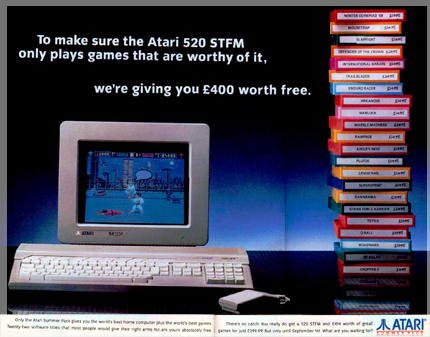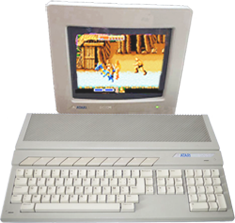"Computer Made for the Masses, not the Classes"

Released in April 1985 for $799, the Atari ST was the first affordable 16-bit computer in the world. Atari’s CEO used to say that the ST is made for the masses, not the classes. Based on the MC68000 CPU, the Atari ST offered a GUI, colorful graphics, and a 3-voice sound chip.
- ST stands for Sixteen/Thirty-two
- The ST line sold more than 2 million units
- Engineered by Shiraz Shivji (who previously worked on the C64 development)
- A feature distinguishing the ST from other computers was the built-in MIDI port and the fantastic Cubase software
Thousands of amateur and professional musicians worldwide have relied on the combination of ST and Cubase.
![]() AT A GLANCE
AT A GLANCE
- MC 68000 CPU running at 8.0 MHz
- TOS 1.0 Operating System (in two 128 KB ROM chips)
- GEM (a fully controlled by mouse GUI)
- 512 KB or 1 MB of RAM (upgradable to 4 MB)
- 16 colors on screen / 512 colors palette
- Three-voice sound synthesis chip from Yamaha
- 3.5-inch 720 KB disk drive
- Hundreds of applications and thousands of video games
 Operating System
Operating System
 The Atari ST used a bitmapped color GUI before any other computer. Originally, Microsoft proposed to port Windows to the ST platform, but Atari refused, as they needed to wait two years. Therefore, they decided to adopt Digital Research's GEM.
The Atari ST used a bitmapped color GUI before any other computer. Originally, Microsoft proposed to port Windows to the ST platform, but Atari refused, as they needed to wait two years. Therefore, they decided to adopt Digital Research's GEM.
- Atari TOS stands for "The Operating System"
- GEM (Graphics Environment Manager) was a direct port of the widely used CP/M to the Motorola 68000
- GEMDOS file system became part of Atari TOS
 Colors & Graphic Modes
Colors & Graphic Modes
The ST supports monochrome, color, and high-resolution monitors and offers a color palette of 512 colors.
- 320 × 200, with 16 out of 512 colors
- 640 × 200, with 4 out of 512 colors
- 640 × 400, with 2 colors
![]() Sound Capabilities
Sound Capabilities
The Atari ST line uses the Yamaha "Programmable Sound Generator" chip. The sound performance was significantly upgraded in the later STE models, and further improved in the Falcon 030 model.
- Yamaha YM2149F PSG sound chip
- Three-voice sound synthesis
- Mono sound (stereo only in STE, TT, and Falcon models)
 I/O Ports
I/O Ports
- 2 DE-9 male mouse/joystick ports
- Monitor port (13-pin DIN)
- DB25 male RS-232c serial port
- DB25 female Centronics printer port
- ACSI (similar to SCSI) DMA port (19-pin D-sub)
- External Floppy Drive Port (14-pin DIN)
- 2 MIDI ports (5-pin DIN)
- ST cartridge port (for 128 KB ROM cartridges)
 Monitors
Monitors
The Atari ST can be connected to TVs, RGB monitors, 15-kHz VGA monitors, or even modern HDMI monitors with video upscaling hardware. Note that the STM/STFM models have a built-in TV modulator, but the output quality is not great.
- Atari original monitors (mono and color monitors)
- TVs via SCART cable (RGB to SCART)
- 15 kHz VGA monitors with an adapter
- Modern VGA/HDMI monitors via video upscaling hardware
 Expansions & Upgrades
Expansions & Upgrades
- 1 MB of RAM and up to 4 MB of RAM (needs modification)
- TOS upgrade
- Gotek drive (internal/exetrnal)
- External hard disk based on SD cards (ACSI2STM, UltraSatan, and ACSI2STM)
- 1.44 MB Floppy Disk (requires board)
- VGA monitor (mono) via adapter
 Related Models: ST Models
Related Models: ST Models
 These are all Atari 520/1040 ST models:
These are all Atari 520/1040 ST models:
- 520ST (512 KB of RAM, external power supply, no floppy disk drive)
- 520ST+
- 520STM (512 KB of RAM, built-in TV modulator)
- 520STFM (512 KB of RAM, built-in floppy disk drive, built-in TV modulator)
- 1040STF (1 MB of RAM, built-in floppy disk drive)
- 1040STFM (1 MB of RAM, built-in floppy disk drive, built-in TV modulator)
The 520ST Models
The first Atari ST was the 520ST. Soon after, the 520STF was released, offering a built-in disk drive. Next, the 520STFM was released, featuring a built-in TV modulator and an integrated disk drive.
-
STFM stands for an ST with a Floppy Disk Drive and Modulator
The 1040ST Models
Released in 1986, the 1040STF offered a built-in disk drive and 1 MB of RAM, which was a big deal for the time. The mouse/ joystick ports moved from the right side of the earlier STs to underneath the keyboard.
-
There was also a 1040 STFM model with a built-in TV Modulator
The Portable Atari ST Models
There were two different Atari ST portable models, both of which are quite rare to find these days:
- Atari STacy (released in 1989, sold about 39,000 units)
- STBook (released in 1991, sold less than 2,000 units)
■ Atari 520/1040 ST
BinaryValue.com (c)















 TOP-10 APPS
TOP-10 APPS
 TOP-30 GAMES
TOP-30 GAMES




